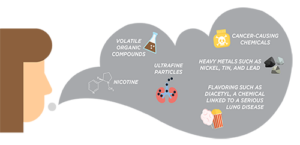Last month the UK Department of Health and Social Care published a paper with the encouraging title: Stopping the start: our new plan to create a smoke-free generation.
There are two main strands to this laudable aim: helping current smokers stop poisoning themselves with tobacco fumes by encouraging them to switch to vaping; and stopping young people from taking up smoking in the first place.
Decent English
Unfortunately, with the exception of the Foreword, it’s so badly written that it’s hard to make sense of it. Why can’t an official publication – it was commissioned by Command of His Majesty King Charles III, no less – be edited by someone who is capable of writing decent English?
First, in the brief Foreword, Professor Sir Chris Whitty, Chief Medical Officer for England, draws attention to some dismal facts:
Smoking damages and cuts short lives in extraordinary numbers. From increasing stillbirths, through asthma in children, to dementia, stroke and heart failure in old age, it causes disability and death throughout the life course. It drives many cancers…
This is echoed in a shorter section of the Foreword by The Rt Hon Steve Barclay, MP, Secretary of State for Health and Social Care. The rest of the paper, however, appears to be anonymous and this is where the trouble starts.
Most preventable
In the following section, which is not just a summary, but an Executive (!) Summary, they wordily rub it in:
Tobacco is the single most important entirely preventable cause of ill health, disability and death in this country…Tobacco use is the world’s single most preventable cause of death and disease.
Oh please. If something is preventable they don’t need to say ‘most preventable’. Perhaps they’re trying to say, ‘Tobacco use is the largest single preventable cause…’ They continue:
Countries around the world have adopted different approaches to tobacco control, reflecting the unique cultural, social and economic contexts in which they operate.
They could simply say: ‘Countries around the world have adopted different approaches to tobacco control.’
Youth vaping
Next, we have the repetitive sentence:
Youth vaping is also becoming a global issue, with countries around the world experiencing increases in vaping use among their younger populations.
This could be reduced to: ‘The increase in youth vaping is becoming a global issue.’
They also quote from the badly written Khan Review:
When used exactly as recommended [sic] by the manufacturer, cigarettes are the one legal consumer product that will kill most users.
And on and on with similar disturbing facts about the devastating impact of smoking which I need not repeat.
Why don’t they ban it then?
The obvious reaction screams out: why don’t they ban it then? Alas, no one seems to hear. Instead, they propose to ‘support existing smokers to quit…by more than doubling the budget for stop smoking services.’ Further, they declare:
Ensuring that vapes continue to be available to current adult smokers is vital to reducing smoking rates.
As I have pointed out, all that vaping does is to help smokers switch their nicotine addiction to an allegedly less harmful way of continuing to put this drug into their body – a counsel of despair and almost an insult.
This is bad enough, but now we have a dilemma. If vapes are available as a quitting ‘tool’ for smokers, children may be encouraged to try vaping and become addicted to nicotine! Therefore, they want to
Call for evidence for measures to reduce the appeal and availability of vapes to children.
Isn’t this absurd, or isn’t it?
Vapes for children: reduce or abolish?
What’s the good of merely reducing the appeal and availability of vapes to children? Vapes should not be available at all to children and therefore their appeal will take care of itself.
Now we come to the heart of the matter. They want to
Propose legislation so that children turning 14 this year or younger will never be legally sold tobacco products…the phased approach means that anyone who can legally be sold tobacco products now will never be prevented from doing so today or in the future.
What is this ‘turning 14 or younger’ business? How much younger? And never be prevented from doing what?
Ill-thought-out
Perhaps they’re trying to say that anyone who can legally buy cigarettes now will not be prevented from doing so in the future. This merely shows how ill-thought-out this proposal is. The current legal age in the UK for buying cigarettes is 18, but it doesn’t stop people under that age buying or somehow obtaining them, so what’s the good of forbidding those aged 14 or younger to buy them?
What about current smokers?
To support existing smokers to quit, the government is more than doubling the budget for stop smoking services, investing an additional £70 million per year (to a total of £138 million), aiming to support around 360,000 people to quit each year…
Recent evidence shows that, for many adult smokers, vapes are an effective tool in supporting smoking cessation, especially when combined with expert support.
The over-used word ‘support’ or derivatives occurs seventy-eight times – on average slightly more than twice on each page.
Wrong-headed
The following repetitive passage sums up the wrong-headedness of the UK government’s approach to the problem:
There is considerable debate about the scale and nature of long-term vaping harms. Not all the risks from vapes have been fully investigated, including inhaling additives for flavours, and the long-term effects of vaping are yet unknown, although further evidence will emerge in the future.
If we take out the unnecessary words we’re left with this: ‘There is debate about long-term vaping harms. These have not yet been fully investigated but further evidence may emerge in the future.’
True, but what will they do with more evidence? We already know that vaping is harmful. The typical vape aerosol contains nicotine, propylene glycol, gycerin, synthetic flavours, tobacco-specific nitrosamines, aldehydes, metal nanoparticle, volatile organic compounds, and trace amounts of other toxins and carcinogens. (Source: Wikipedia and passim.) And typical vapers take hundreds of lungfuls of this chemical soup every day. Obviously it’s not going to do them any good.
I’ll end with one more quote from this paper:
The government has never and will not criminalise smoking.
I have never and will not suggest that they do, but I have repeatedly called for the manufacture and sale of tobacco products to be banned. If these products are no longer available for purchase in every corner shop and supermarket, then this would be the single most effective measure to achieve a smoke-free society.
Text © Gabriel Symonds
Picture credit: cdc.gov


Leave A Comment